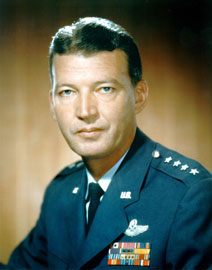Remembering Bernard Schrieverby Taylor Dinerman
|
| In 1954, as head of the Western Development Division, General Schriever was given responsibility for developing both the Air Force’s ICBM programs and some of the early work on what later became the Corona spy satellite. |
At the end of the war he returned to Washington where, according to a piece he published in 1995, Hap Arnold, who had lead the Army Air Forces throughout since 1939 told him “…that we had won the First World War with brawn and the Second World War with logistics… Arnold said that the next major war would be won by brainpower.” He then encouraged Schriever to begin cooperating with civilian scientists such as Theodore von Karman. Together they encouraged Project Rand (later the Rand Corporation) to begin a series of studies that looked into the possibilities of long-range rockets and reconnaissance satellites.
In the late 1940s he was part of a group that encouraged the creation of the Air Research and Development Command (ARDC). This organization fulfilled Hap Arnold’s ambition for the Air Force to commit itself to staying on the cutting edge of science and technology.
In 1954, as head of the Western Development Division, General Schriever was given responsibility for developing both the Air Force’s ICBM programs and some of the early work on what later became the Corona spy satellite. His organization began work on the Atlas in 1955 and later developed the Titan, Thor, and Minuteman missile programs. More than anyone else, he was responsible for the fact that the “missile gap” issue, exploited by the Democrats in the 1960 election, was just a myth.
In spite of the high priority given to the long-range rocket programs, progress was difficult. Schriever had managed to gain some immunity for his organization from the routine bureaucratic procurement regulations; this allowed for the development and procurement of these missiles in what is probably still record time for large-scale US military programs. Atlas went from drawing board to deployment in a little more than five years, Thor in three and a half years, Minuteman in about four years.
In 1959 he took command for ARDC, which then evolved into Air Force Systems Command with wide responsibility for changing the basic approach to procurement. At Systems Command he was responsible for the wide-ranging “Project Forecast”, a comprehensive look at what future technology could do.
By 1966 his differences with Robert McNamara on technological and nuclear policy led him to take early retirement. These were the years when many officers felt that the Johnson Administration was deliberately slowing down the pace of technological advancement in pursuit of an illusory Cold War balance.
| In 1995 he presciently warned that the US was not pursuing the survivability of its peacetime space assets. |
After retirement General Schriever kept working hard for the Air Force and for America. It is said that he had an old-fashioned immigrant’s love of this country that was as deep as it was intense. He constantly pushed the idea that America had to maintain its excellence in science and technology. The Air Force is what it is today because of men like General Schriever, whose brains and dedication helped win the Cold War. High-quality military technological leadership is a rare thing and America should be grateful that, when duty called, a few men like General Schriever were there to stand up and be counted.
In 1995 he presciently warned that the US was not pursuing the survivability of its peacetime space assets. “In fact,” he said, “survivability is one of the most important requirements that we impose on our military systems. Unfortunately, we have not applied that requirement as rigorously in the space arena.”
